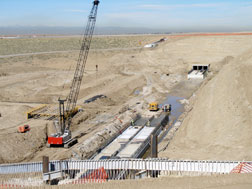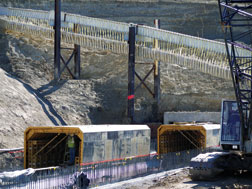De-Ice Pad "WA" - Denver International Airport
Project Focus
 |
Project Details
Schedule & Complexity
The project was "sandwiched" between two active taxiways and involved constructing a VSR that crossed another taxiway. New lighting requirments forced removal and replacement of concrete panels in an intersection where five taxiways came together.
 |
A 950 foot concrete box culvert, 30' wide and 16' high, had to be built in an existing creek bed to provide for a major drainage under the new WA taxiway and de-icing pad. Scheduling was maintained by slipforming the box to shorten its duration. Earth fill was placed in depths up to 60 feet, with 120-days allowed for settlement prior to placement of stabilized subgrade and pavement layers, minimizing the potential for pavement settlement in this high fill area. A de-icing control building was constructed on 100' caissons along with four glycol dispensing stations, over four miles of glycol piping and an 800,000 gallon glycol recovery storage tank. The project constructed 85,000 SY of 17" concrete pavement of 8" of cement trated base and 12" of cement treated soil, with 28,000 LF of trench drain and 2400 LF of surface drains.
Construction & Innovation
A Rex central mix concrete plant was modified to allow introduction of ground granulated blast furnace slag, that provided heated concrete throughout the winter, as a 'third' cementitious product in addition to the Portland cement and flyash. Design placement of five tranch drain sections and apron dimensions of about 600' x 1000' required the paving crew to place & finish as many as twelve headers while completing two paving lanes in a day. A ready mix plant was dedicated to the box contruction to meet the dmands of a tight schedule. The project team also worked with airport operations to combine work areas with other contracts to minimize disruptions to the normal airport traffic flow.
Quality
A six step QC inspection process maintained controls from pre-work coordination through final acceptance. Profile smoothness averaged 2.0 inches per mile despite the numerous headers and short paving sections.
 |
Public Relations
Groundbreaking ceremony was held with the Army, Air Force, U.S. Army Corps of Engineers, and the mayor of Colorado Springs in May and was covered by all local TV stations.